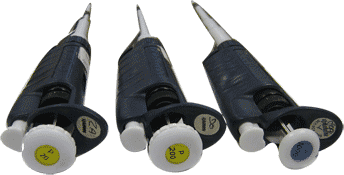Lab Bench Tool of the Day: The Micropipetter
 This next section introduces you to the use of a micropipette, which is a very basic instrument used regularly in conducting laboratory experiments. A micropipette allows you to collect and transfer very small amounts of fluid. As we go through this section, you will also see why it is important to familiarise yourself with the metric vocabulary and be able to do conversions that we learnt in the previous section.
This next section introduces you to the use of a micropipette, which is a very basic instrument used regularly in conducting laboratory experiments. A micropipette allows you to collect and transfer very small amounts of fluid. As we go through this section, you will also see why it is important to familiarise yourself with the metric vocabulary and be able to do conversions that we learnt in the previous section.
How to select a micropipetter
 Before we start, I want to emphasize the importance of this topic. Improperly-used pipetmen have been known to explode on contact with hard surfaces, burst into flame while sitting unattended on conference tables, and even destroy the inner workings on the expensive pipetman, annoying your hard-working researcher.
Before we start, I want to emphasize the importance of this topic. Improperly-used pipetmen have been known to explode on contact with hard surfaces, burst into flame while sitting unattended on conference tables, and even destroy the inner workings on the expensive pipetman, annoying your hard-working researcher.
OK, now that I have your attention.
- You need to know which pipetman to choose.
- You need to know that pipetmen are not accurate outside of their recommended range
- You need to know how to interpret the numbers on the volume indicator.
There are several standard sizes of pipetman, but this module will focus on 3 commonly used standard sizes called the P20, P200, and P1000. They measure between 2-20µl, 20-200µl or 200-1000µl respectively. The rule for choosing between them is simple: use the smallest pipetman you can, and use it within the recommended volume ranges.
*Fine print: in most of the pipetmen the volume range (minimum and maximum volume) is indicated on the top of the push button.
For example, say you need to measure out 25 microlitres of a solution. Twenty-five is too big for a P20, so DON'T USE IT, ok? 25 microlitres is within the recommended range of the P200 but not of the P1000, so choose the P200. That way you will get a more accurate measurement.
 Oh, yeah, then get the tip. In most cases, this part is easy because they're colour-coded to the plunger on the pipette:
Oh, yeah, then get the tip. In most cases, this part is easy because they're colour-coded to the plunger on the pipette:
- Yellow plunger = yellow (or clear) tip
- Blue plunger = blue tip
Not exactly rocket science, but can have serious consequences on your results if you get them wrong!
Which Pipette is Which?
|
|
People with diabetes need to measure their blood sugar using a glucometres which requires a sample of up to 12 microlitres of blood. Which pipetman could you use to measure this amount? |
|
|
Some superfast glucometres require as much as 25 microlitres of blood. Which pipetman would you use to measure this amount? |
|
|
Part of the process of making glucose test strips for diabetes involves pipetting 210 microlitres of glucose oxidase into the reactive mixture. Which pipetman should be used for this purpose? |
|
|
Copyright University of Maryland, 2007
You may link to this site for educational purposes.
Please do not copy without permission
requests/questions/feedback email: mathbench@umd.edu